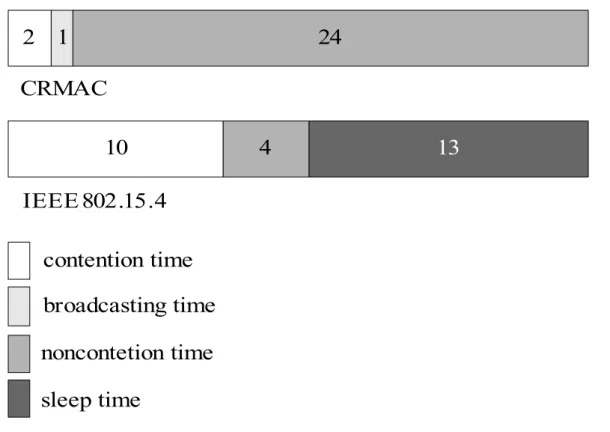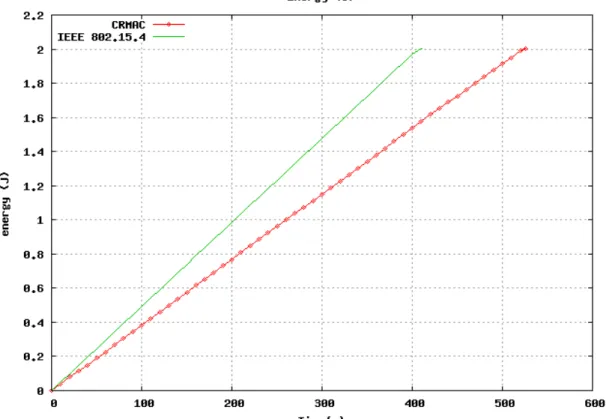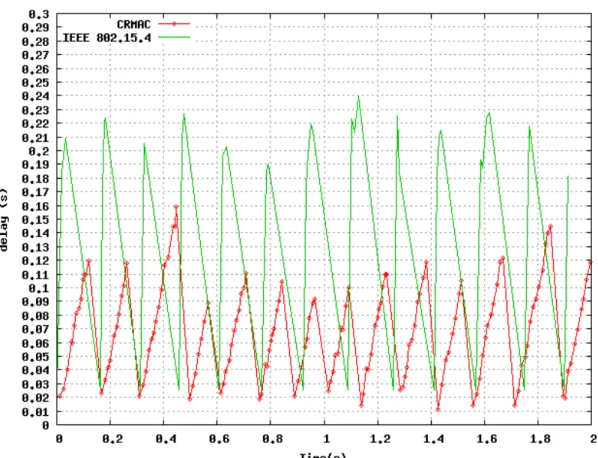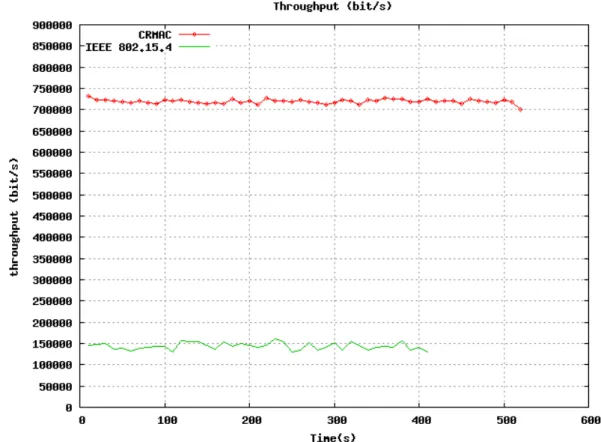A
N
E
FFICIENT
MAC P
ROTOCOL
B
ASED
ON
H
YBRID
S
UPERFRAME
FOR
W
IRELESS
S
ENSOR
N
ETWORKS
Ge Ma and Dongyu Qiu
Department of Electrical and Computer Engineering
Concordia University, Montreal, QC, Canada
tina0702@gmail.com, dongyu@ece.concordia.ca
A
BSTRACTDesigning low energy consumption, high efficiency Media Access Control (MAC) protocols are one of the most important directions in wireless sensor networks (WSN). In this paper, we proposed a new contention reserve MAC protocol, named CRMAC, under the inspiration of IEEE 802.15.4’s superframe structure. CRMAC is a MAC protocol suitable for intra-cluster WSN that combines the advantages of contention and schedule-based MAC protocols. We introduce the mechanism and superframe structure of CRMAC in detail and verified the performance of this protocol through simulations. Our results show that CRMAC performs better than IEEE 802.15.4 in energy consumption, system delay and network throughput. CRMAC is especially suitable for short packet transmission under low load networks, which is the main situation in WSN.
K
EYWORDSWSN, MAC, CRMAC, Superframe
I. I
NTRODUCTIONDue to the rapid development and growing maturity of technologies such as MEMS, mobile communication, embedded computing technology, and wireless sensors, it becomes possible now that a large amount of low cost wireless sensors can create a wireless sensor network (WSN) by mobile links. It has been proved that WSN is gaining fast development after being brought forward. Compared to traditional WLAN, WSN has some specific characteristics, such as flexible placement, simple expansion, etc. Typical applications of WSN include monitoring, tracking, and controlling.
According to existed protocols, using wireless channels is based on Media Access Control (MAC) protocols which allocate wireless resources and control the way that sensors access a shared radio channel to communicate with their neighbours. When designing a MAC protocol for a WSN, main considerations should be: energy efficiency, propagation delay, network scalability, throughput, fairness, and bandwidth utilization. Among them, energy consumption is usually the most important one. So it is necessary to find and analyze the reasons that cause energy loss. In general, sensors’ ineffective energy consumption can be summarized as: protocol overhead, collisions, overhearing, and idle listening. Some early papers are most designed by adding dormancy mechanisms suitable for WSN. Many of later papers are built upon those, and make improvement and optimization on the factors above.
the channel using Time Division Multiple Access (TDMA) like mechanisms; many characters in TDMA are suitable for the requirements of WSN. This kind of protocols has no collision problem as in contention-based protocols; data transmission does not need much overhead; by adding sleep period to avoid long time of sensing channel and using the channel efficiently are all its positive aspects in terms of energy saving. This kind of protocols, however, does not perform quite well in network flexibility and synchronization. LMAC [4], BMA [5], and EE-MAC [6] are its representative examples.
There is also one hybrid protocol that is now concerned a lot in WSN; it is IEEE 802.15.4 [6]. It provides a superframe structure as a complimentary program, which contains both contention and schedule phases. It is now a main and very popular discussing topic in WSN, which ensures the flexibility of access and meanwhile balances some requirements in QoS bandwidth and flow. IEEE 802.15.4 provides cheap equipment with low-complexity, low-cost, low-power, low-rate wireless internet standard. The superframe structure has its advantages compare to pure contention or schedule-based MAC protocols. However, this protocol still has some improvement space. For example, in IEEE 802.15.4, guaranteed time slots (GTS) of superframe must be reserved in the previous superframe; the requirements of GTS can only be applied by the equipment that is already built up connection, and its basic connection method is still contention-based mechanism–Slotted CSMA/CA. Thus, this protocol still cannot jump out from the restriction of contention-based mechanism in terms of energy consumption, throughput, etc. This also motivated us to further study this protocol and hand out some new ideas.
This paper proposed an improved MAC model-Contention Reserve MAC Protocol –CRMAC, based on a deep analysis of the pros and cons of IEEE 802.15.4. CRMAC uses a hybrid superframe structure as well as IEEE 802.15.4; it sends short slot reserve packets using CSMA to the cluster-head and obtains permission to send their real data in the following GTS. By doing this, it can efficiently reduce the probability of collisions as well as propagation delay and thus increase energy efficiency. Through simulation, we get that CRMAC generates better performance in energy consumption, delay, throughput, and network life-cycle compare to IEEE 802.15.4.
The rest of the paper is organized as follows: In Section II, we present a detail description of CRMAC protocol. In Section III and Section IV, we evaluate and analyze the performance of our protocol by simulations. Finally, the paper is concluded in Section V.
II. CONTENTION RESERVE MAC PROTOCOL-CRMAC
CRMAC protocol combines the specific characteristics of contention-based and schedule-based MAC protocols, which effectively connects contention mechanism and slot allocation together. This protocol can be applied to WSN to use the resource more efficiently, which means to perform better in system delay and throughput under low energy consumption
A. Protocol Description
As in LEACH [7], which randomly rotates the cluster head to distribute the energy consumption evenly among all sensors in the network, CRMAC is also a cluster-based protocol, we divide its operation into rounds, and each round consists of a setup phase and several superframes, which are further divided into: slot reserve step, schedule assigned step and guaranteed data transmission step.
GTS GTS
……
Slot Reserve Guaranteed Data Transmission Schedule Assigned Setup PhaseGTS GTS
……
Slot ReserveGuaranteed Data Transmission Schedule
Assigned
Super Frame 1 Super Frame 2
……
Figure 1 CRMAC Superframe Structure
B. Structure
1) Set-up Phase: nodes in the network form clusters and elect cluster heads similar as in LEACH: Certain node is selected as the cluster-head from randomized rotation among the same structure sensors. In this phase, each node decides whether to take the role of the cluster head based on its own energy level to avoid draining the battery of any particular node. The selected cluster head will then broadcast an announcement to other sensors within the cluster area. Nodes that receive this will join the cluster accordingly. If using powerful nodes such as FFD (full function device) in IEEE 802.15.4 as organizers, then we do not need this phase and will jump directly to the next step.
2) Superframe: After the cluster is setup, the entire network will enter the steady state, which is followed by several superframes.
a) Slot Reserve Step: Cluster-head collects information from common nodes that have data to send, they must apply for the slots. In this step, all nodes are kept awake and they use CSMA to communicate with the cluster head, once nodes get the channel, they immediately send a short packet which contains slot reserving information showing data transmission request. At the end of this step, cluster-head will form a schedule table based on this information. We define fixed time length for this step. Once the time is out, nodes that do not make the reservations will lose the chance of sending data. This can ensure not to waste too much time. We choose CSMA instead of slotted CSMA/CA as IEEE 802.15.4 does, since data length in reserving application possesses is much shorter, if using slotted CSMA/CA, time occupation rate in wireless channel will be very low and waste more energy.
b) Schedule Assigned Step: Cluster head aggregates the information based on the previous step and broadcasts the schedule table. It will also finish the synchronization task in this step to make sure that at the end of this step, all nodes have the same schedule table.
c) Guaranteed Data Transmission: Nodes only need to transmit data according to the schedule table. Communication is entirely contention-free TDMA mechanism: in any specific slot, only the owner of the slot can use the channel to transmit data to the cluster-head, and all other nodes will fall asleep.
III. SUPERFRAME STRUCTURE SETUP
According to the parameters in IEEE 802.15.4 standard and the definition of CRMAC, we set the superframe structure of the two protocols as follows:
10
4
13
2
1
24
contention time
broadcasting time
noncontetion time
sleep time
IEEE 802.15.4
CRMAC
Figure 2 Comparison of superframe structures
Physical layer’s transmission rate is 1Mbit/s, set one slot as 5ms (time for transmitting 625byte).
A. CRMAC
We set 10ms of time period for contention reserve step in CRMAC, which are 2 time slots. Allocate 1 slot for schedule assigned step to assure broadcasting bacon is received correctly and synchronized. Considering full usage of slots, when nodes apply for data transmission, it can reserve for both integer and non-integer time slots. Assume reserved slots are uniformly distributed from 1 to n. Assume M nodes within a cluster and they all have data to send, about 60% of them can successfully make the channel reservation. Figure 2 shows an example about the slots allocation in one superframe, which is applied in our simulation. So we will have about 12 nodes each round that can send data in the following step which occupy the slots from 1 to 3, the expectation value of total slots in this step is thus,
(
)
(
) 12 2 24
E sum
E nodei
i
=
∑
= × =
So in CRMAC, the length of a superframe is about:
L=contension+broadcasting+noncontension
=2+1+24=27slots
B. IEEE 802.15.4
randomly and uniformly select slots which are distributed from 1 to 3; the expectation value of each node is 2 slots and the expectation value is thus,
(
)
(
) 2 2 4
E sum
E nodei
i
=
∑
= × =
To make sure IEEE 802.15.4 and CRMAC are compared under the same condition, set
the superframe of the two protocols as the same length, so sleeping (inactive) period in
IEEE 802.15.4 is:
Sleep_time = superframe - contention - noncontension
=27-10-4=13slots
IV. SIMULATIONS
To test CRMAC protocol that we proposed, we evaluate its network performance in network simulator ns-2 [8] and compare it to another protocol-IEEE 802.15.4.
A. Simulation Model
For our simulation, we apply the same network model for IEEE 802.15.4 and CRMAC. We spread 20 nodes that randomly in a 10m by 10m bounded area, and we run the simulation for 600ms. We assume a simple model that a clustered network has already been built. A central access node act as a cluster head is placed randomly in the area and source nodes will send data to the cluster head directly. Source nodes compete to send short reserve packets at the same time.
B. Result Discussion
Figure 3 Energy Consumption Comparisons
In the figure above, two curves have an overall upward trend, which is because energy
consumption is gradually increased with time; strong vibration of two curves is because:
a) In CRMAC, nodes spend the time in contention phase is much shorter, so in IEEE
802.15.4, nodes need to be active for longer time, thus its energy consumption is high.
b) When the slope is bigger, nodes are in data transition (active) state. While with
smaller slope, nodes are in sleep state or do not in the working slot of schedule table
that nodes only consume 1mW power, much smaller than active state.
c) Each time the slot allocation is different, thus curve has some randomization in short
term. By figure 4, we get long term statistic of nodes’ energy consumption shown as the
stability to some extend.
Set each node’s original energy as 2J. When consumes 2J of energy, nodes lose the
effect. From the figure below, the slope is perpendicular in IEEE 802.15.4 leads to
consuming 2J sooner, so its overall efficiency of lifetime according to the simulation is
lower than CRMAC. Although in IEEE 802.15.4 we add sleep period to prolong system
lifetime, due to its relative long contention period compared to CRMAC, it still
consumes more energy.
Figure 4 Comparison of Lifetime
150.56ms and 68.61ms in CRMAC. Since data transmission task is periodic, so delay is
also changed periodically in the figure.
Figure 5 Comparison of Delay
3) Throughput. The figure below shows throughput comparison of two protocols. In
IEEE 802.15.4, due to higher possibility of collisions in contention period, it may lead
to data drop after times of retry. Meanwhile, long duration of the sleeping period will
lower the service rate and will lead to lower throughput: about 150kbit/s in the
simulation. CRMAC allocates the channel by slots, there won’t be collision. And
because it does not have a sleeping period, the protocol will have a better throughput
and the service rate: about 725kbits/s. based on the data in simulation, throughput in
CRMAC is about 4.83 times of IEEE 802.15.4.
V. CONCLUSIONS
Figure 6 Comparison of Throughput
R
EFERENCES[1] A. El-Hoiydi, J.-D. Decotignie, "WiseMAC: an ultra low power MAC protocol for the downlink of infrastructure wireless sensor networks," iscc, vol. 1, pp.244-251, Ninth IEEE Symposium on Computers and Communications 2004 Volume 1 (ISCC'04), 2004
[2] Wei Ye, J. Heidemann, D. Estrin, "An energy-efficient MAC protocol for wireless sensor networks," in Proceedings of IEEE INFOCOM, vol.3, no., pp. 1567-1576 vol.3, 2002
[3] Tijs van Dam, Koen Langendoen, “An Adaptive Energy Efficient MAC Protocol for Wireless Sensor Networks”, Proc 1st Int’ Conf on Embedded Networked Sensor System, Nov. 5-7,2003, Los Angeles, CA.
[4] L.van Hoesel and P. Havinga. A lightweight medium access Protocol (LMAC) for wireless sensor networks. In 1st Int. workshop on Networked Sensing Systems (INSS 2004), Tokyo,Japan, June 2004.
[5] Jing Li and Georgios Y. Lazaroul, “A Bit-Map-Assisted Energy-Efficient MAC Scheme for Wireless Sensor Networks”, Information Processing in Sensor Networks, 2004. IPSN 2004. Third International Symposium on 26-27 April 2004.
[6] S. Rahimi, D. Qiu, “A Novel Energy-Efficient Media Access Control Protocol for Wireless Sensor Networks”, in Proceedings of IASTED Wireless and Optical Communications, Montreal, QC, Canada, May 2007.
[7] IEEE 802 Part 15.4: Wireless Medium Access Control (MAC) and Physical Layer (PHY) Specifications for Low-Rate Wireless Personal Area Networks (LR-WPANs).




